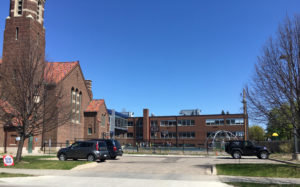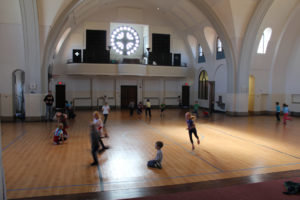By TESHA M. CHRISTENSEN
The Twin Cities German Immersion School (TCGIS) has outgrown its current building at 1031 Como Ave. and plans to expand on its existing site.
School administrator Gael Braddock told District 10’s Land Use Committee the expansion most likely will require extensive renovation or replacement of the old Saint Andrew’s church building.
No work is likely until at least fall 2018.
School is in high demand
Outgrowing its site isn’t a new problem for the school, but one it has faced consistently as the students who come decide to stay, and more want to attend.
“Our school is in high demand, which points to the great work that our staff does with our children and families every day,” observed TCGIS Executive Director Ted Anderson. “Three hundred plus families trust us with their kids, and that is a huge vote of confidence in this age of school choice.”
 Photo right: The Twin Cities German Immersion School has outgrown its current building at 1031 Como Ave. and plans to expand on its existing site. The expansion most likely will require extensive renovation or replacement of the old Saint Andrew’s church building. (Photo by Tesha M. Christensen)
Photo right: The Twin Cities German Immersion School has outgrown its current building at 1031 Como Ave. and plans to expand on its existing site. The expansion most likely will require extensive renovation or replacement of the old Saint Andrew’s church building. (Photo by Tesha M. Christensen)
St. Paul residents Jeff and Gita Zeitler have sent both of their children, an 8-year-old and a 10-year-old, to TCGIS since kindergarten.
“We love the school for a lot of reasons—parents are involved, and the teachers are wonderful!” stated Jeff Zeitler. “Becoming fluent in German is frosting on the cake. Our kids are already learning Nepali from their mom at home, so they’re on their way to becoming trilingual.”
The Zeitlers’ first choice of school was the closest St. Paul Public school, but the boundaries were drawn such that they couldn’t get in and were re-routed to a school much further away. So they checked into TCGIS and other charter schools and were impressed by what they saw at TCGIS.
Once families enroll, they don’t leave
The tuition-free German Immersion School opened its doors in the fall of 2005 with kindergarten and first grade at the old Union Hall along Eustace Ave. As it grew by adding a new kindergarten class each year, it moved to a larger but 90-year-old office building at 1745 University Ave. In the 2012-2013 school year, TCGIS reached its full configuration as a K-8 school.
The next year, it moved its 370 students to the recently renovated former home of St. Andrews Catholic Church and parochial school in the Warrendale neighborhood along Como Ave.
The charter school’s small class sizes help ensure individualized attention for up to 24 students per class. The school offers full-day immersion kindergarten, English instruction beginning in third grade, and Spanish language in the seventh grade.
In its fifth year on the Como Ave. site, TCGIS is experiencing its first year of being over its designed capacity, according to Anderson.
The Como Ave. site was built for 23 individual class sections and 560 pupils. This year, the school has 24 class sections and more than 525 pupils.
If current student retention patterns hold, TCGIS could have as many as 27 class sections, K-8, by the school year 2020-21.
Anderson says the unanticipated growth is primarily the result of unusually high retention rates; in other words, once families enroll in the school, they don’t leave.
Options explored
Through its strategic planning work, the TCGIS School Board resolved and announced that TCGIS would remain a K-8 school and keep all grades on the same site.
“With these parameters set, the Facilities Committee explored the possibilities of renting space across the street in the long term and acquiring additional property, neither of which have proven possible,” wrote Anderson in a letter to the school community. “In the last months, it has become clear that construction on our current footprint will be our solution to the space issue.”
 Photo left: When the German Immersion School moved into the former St. Andrew’s church site, it converted the former church sanctuary into a multi-purpose gym and auditorium, and constructed a new building to connect the existing structures. (Photo submitted)
Photo left: When the German Immersion School moved into the former St. Andrew’s church site, it converted the former church sanctuary into a multi-purpose gym and auditorium, and constructed a new building to connect the existing structures. (Photo submitted)
Before moving into the 60,580 square feet at their current location, Welsh Construction managed a project that included converting the former church sanctuary into a multi-purpose gym and auditorium, and constructing a new building to connect the existing structures.
The School Board’s Facilities Committee, chaired by board member Nic Ludwig, is working to develop a timeline, budget, and plan for expansion of the school’s spaces to accommodate growth.
“In addition to creating more space, the situation also presents the opportunity to improve our existing facilities,” according to Anderson. The conversation includes classrooms, gym, cafeteria, Special Education (office, learning spaces), office/administration, and fine arts.
The School Board’s Facilities Committee meets monthly, and the meetings are open to the community.
School addressing concerns
School staff has also begun meeting regularly with District 10 board members and staff to address parking, noise, and congestion concerns surrounding school activities.
The school has designated Director of Operations Gael Braddock as Neighborhood Liaison and is the go-to person for neighbors’ concerns.
Orthodox Presbyterian Church has agreed to share its parking lot with the school, and TCGIS is also exploring the viability of using the Como Pool lot for parking.
School staff have been asked to leave at least one space per house open on Van Slyke, and encourage parking on Horton and Jessamine in spots that are not in front of residences.
In regards to complaints about noise from the playground, the school is considering installing a new fence to provide some visual and noise protection.
Over the summer, the crumbling playground surface, which is the same used at other St. Paul schools, was fixed by the manufacturer.
“The building TCGIS is in has been a school since the 1950s,” pointed out Zeitler, who is concerned that some neighbors are trying to push the school out of the neighborhood.
“I think there is sometimes a feeling that we own the space on the streets in front of our houses, and I can sympathize since we also live in St. Paul and dislike it when tenants of the apartment buildings across the street park in front of our house. But we live in the city, and that’s one of the trade-offs—tight parking.”
He added, “This has been a school for generations, so any neighbors were well aware that they were going to live near a school when they purchased their house. This is not a nuclear waste storage site. It’s a school—an integral part of a healthy community.”
Comments
No comments on this item Please log in to comment by clicking here